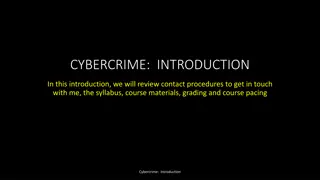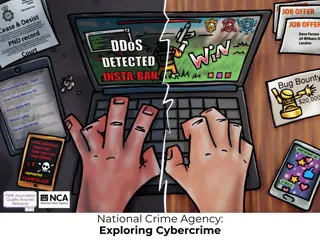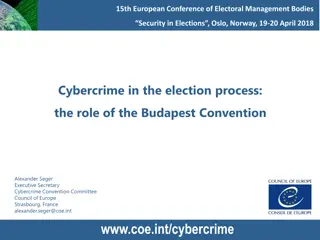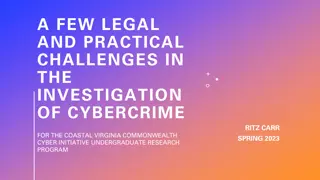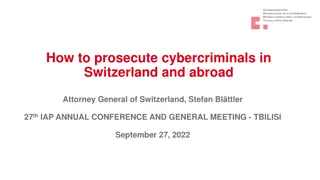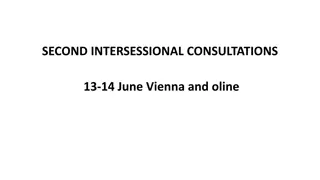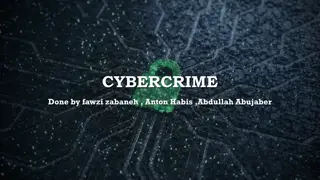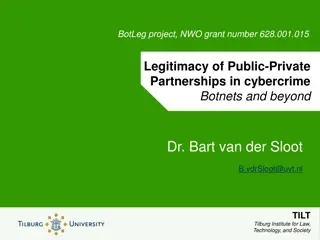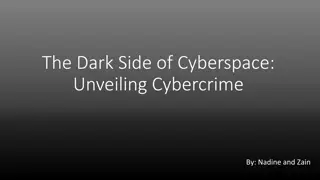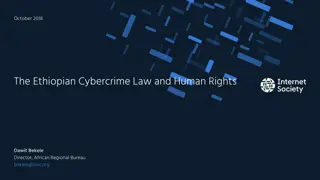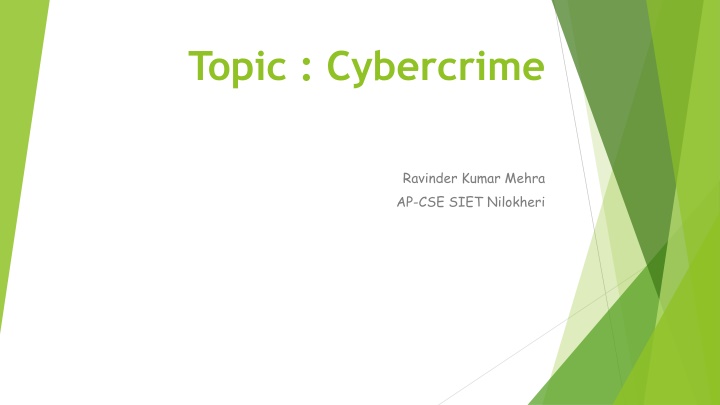
Cybercrime: Threats, Impact, and Prevention
Explore the world of cybercrime through this comprehensive guide covering various aspects such as types of cybercrimes, criminals involved, financial impact, and prevention strategies. Learn how cybercriminals target both individuals and computer systems, and discover common cybercrimes like phishing, malware, and identity theft. Stay informed and safeguard yourself against the growing threat of cybercrime.
Download Presentation

Please find below an Image/Link to download the presentation.
The content on the website is provided AS IS for your information and personal use only. It may not be sold, licensed, or shared on other websites without obtaining consent from the author. If you encounter any issues during the download, it is possible that the publisher has removed the file from their server.
You are allowed to download the files provided on this website for personal or commercial use, subject to the condition that they are used lawfully. All files are the property of their respective owners.
The content on the website is provided AS IS for your information and personal use only. It may not be sold, licensed, or shared on other websites without obtaining consent from the author.
E N D
Presentation Transcript
Topic : Cybercrime Ravinder Kumar Mehra AP-CSE SIET Nilokheri
Introduction Cybercrime, a computer and a network.[1] computer-oriented crime, or is a crime that involves The computer may have been used in the commission of a crime, or it may be the target.[2] Cybercrime may threaten a person or a nation's security and financial health. Debarati Halder and K. Jaishankar further define cybercrime from the perspective of gender and defined 'cybercrime against women' as "Crimes targeted against women with a motive to intentionally harm the victim psychologically and physically, using modern telecommunication networks such as internet and mobile phones".[3] Cybercrime is crime committed on the Internet, on local networks, or even against isolated computers. It can affect any of your digital devices (including PCs, notebooks, smart TVs, tablets, smartphones, home electronic systems, etc). Cybercrime also refers to any activity where crime is committed using any computer system.
Cyber criminals are publicly known as hackers, although the term is technically inaccurate, the correct term is cracker . A report (sponsored by McAfee), published in 2014, estimated that the annual damage to the global economy was $445 billion.[4]Approximately $1.5 billion was lost in 2012 to online credit and debit card fraud in the US.[5]In 2018, a study by Center for Strategic and International Studies (CSIS), in partnership with McAfee, concludes that close to $600 billion, nearly one percent of global GDP, is lost to cybercrime each year.[6]
Computer as a target These crimes are committed by a selected group of criminals. Unlike crimes using the computer as a tool, these crimes require the technical knowledge of the perpetrators. As such, as technology evolves, so too does the nature of the crime. These crimes are relatively new, having been in existence for only as long as computers have which explains how unprepared society and the world, in general, is towards combating these crimes. There are numerous crimes of this nature committed daily on the internet. It is seldom committed by loners, instead it involves large syndicate groups. Crimes that primarily target computer networks or devices include: Computer viruses Denial-of-service attacks Malware (malicious code)
Computer as a tool When the individual is the main target of cybercrime, the computer can be considered as the tool rather than the target. These crimes generally involve less technical expertise. Human weaknesses are generally exploited. The damage dealt is largely psychological and intangible, making legal action against the variants more difficult. These are the crimes which have existed for centuries in the offline world. Scams, theft, and the likes have existed even before the development in high-tech equipment. The same criminal has simply been given a tool which increases their potential pool of victims and makes them all the harder to trace and apprehend.[30] Crimes that use computer networks or devices to advance other ends include: Fraud and identity theft (although this increasingly uses malware, hacking or phishing, making it an example of both "computer as target" and "computer as tool" crime) Information warfare Phishing scams Spam Propagation of illegal obscene or offensive content, including harassment and threats The unsolicited sending of bulk email for commercial purposes (spam) is unlawful in some jurisdictions. Phishing is mostly propagated via email. Phishing emails may contain links to other websites that are affected by malware.[31]Or, they may contain links to fake online banking or other websites used to steal private account information.
Cyber Crime Classifications Financial fraud crimes Computer fraud is any dishonest misrepresentation of fact intended to let another to do or refrain from doing something which causes loss. In this context, the fraud will result in obtaining a benefit by: Altering in an unauthorized way. This requires little technical expertise and is a common form of theft by employees altering the data before entry or entering false data, or by entering unauthorized instructions or using unauthorized processes; Altering, destroying, suppressing, or stealing output, usually to conceal unauthorized transactions. This is difficult to detect; Altering or deleting stored data; Other forms including bank fraud, carding, identity theft, extortion, and theft of classified information. These types of crime often result in the loss of private information or monetary information. of fraud may be facilitated using computer systems,
Cybercrime against individuals This is the one that directly affects any person or their properties. Examples of this type of cybercrime include but are not limited to: social engineering, phishing, email harassment, cyber stalking and spreading illegal adult materials. Harassment via e-mails a) Email spoofing (Online a method of sending e-mail using a false name or e-mail address to make it appear that the e-mail comes from somebody other than the true sender.) b) Cyber pornography (exm.MMS) Cyber-stalking. Dissemination of obscene material. Defamation. Unauthorized control/access over computer system. Indecent exposure Email spoofing Cheating & Fraud Breach of Confidentiality
Cyberterrorism Government officials and information technology security specialists have documented a significant increase in Internet problems and server scans since early 2001. There is a growing concern among government agencies such as the Federal Bureau of Investigations (FBI) and the Central Intelligence Agency (CIA) that such intrusions are part of an organized effort by cyberterrorist foreign intelligence services, or other groups to map potential security holes in critical systems.[8] A cyberterrorist is someone who intimidates or coerces a government or an organization to advance his or her political or social objectives by launching a computer-based attack against computers, networks, or the information stored on them. Cyberterrorism, in general, can be defined as an act of terrorism committed through the use of cyberspace or computer resources (Parker 1983). As such, a simple propaganda piece on the Internet that there will be bomb attacks during the holidays can be considered cyberterrorism. There are also hacking activities directed towards individuals, families, organized by groups within networks, tending to cause fear among people, demonstrate power, collecting information relevant for ruining peoples' lives, robberies, blackmailing, etc.[9]
Cyberextortion Cyberextortion occurs when a website, e-mail server, or computer system is subjected to or threatened with repeated denial of service or other attacks by malicious hackers. These hackers demand money in return for promising to stop the attacks and to offer "protection". According to the Federal Bureau of Investigation, cybercrime extortionists are increasingly attacking corporate websites and networks, crippling their ability to operate and demanding payments to restore their service. More than 20 cases are reported each month to the FBI and many go unreported in order to keep the victim's name out of the public domain. Perpetrators typically use a distributed denial-of-service attack.[10]However, other cyberextortion techniques exist such as doxing extortion and bug poaching. An example of cyberextortion was the attack on Sony Pictures of 2014.[11]
Cybersex trafficking Cybersex trafficking is the transportation of victims and then the live streaming of coerced sexual acts and or rape on webcam.[12][13][14][15]Victims are abducted, threatened, or deceived and transferred to 'cybersex dens.'[16][17][18]The dens can be in any location where the cybersex traffickers have a computer, tablet, or phone with internet connection.[19] Perpetrators use social media networks, videoconferences, dating pages, online chat rooms, apps, dark web sites,[20]and other platforms.[21] They use online payment systems[22][23][24]and cryptocurrencies to hide their identities.[25]Millions of reports of its occurrence are sent to authorities annually.[26] New legislation and police procedures are needed to combat this type of cybercrime.[27] An example of cybersex trafficking is the 2018 2020 Nth room case in South Korea.[28]
Cyberwarfare The U.S. Department of Defense notes that the cyberspace has emerged as a national-level concern through several recent events of geostrategic significance. Among those are included, the attack on Estonia's infrastructure in 2007, allegedly by Russian hackers. In August 2008, Russia again allegedly conducted cyber attacks, this time in a coordinated and synchronized kinetic and non-kinetic campaign against the country of Georgia. The December 2015 Ukraine power grid cyberattack has also been attributed to Russia and is considered the first successful cyber attack on a power grid. Fearing that such attacks may become the norm in future warfare among nation- states, the concept of cyberspace operations impacts and will be adapted by warfighting military commanders in the future.[29]
Obscene or offensive content The content of websites and other electronic communications may be distasteful, obscene or offensive for a variety of reasons. In some instances, these communications may be illegal. The extent to which these communications are unlawful varies greatly between countries, and even within nations. It is a sensitive area in which the courts can become involved in arbitrating between groups with strong beliefs. One area of Internet pornography that has been the target of the strongest efforts at curtailment is child pornography, which is illegal in most jurisdictions in the world.
Drug trafficking Darknet markets are used to buy and sell drugs online. Some drug traffickers use encrypted messaging tools to communicate with drug mules. The dark web site Silk Road was a major online marketplace for drugs before it was shut down by law enforcement (then reopened under new management, and then shut down by law enforcement again). After Silk Road 2.0 went down, Silk Road 3 Reloaded emerged. However, it was just an older marketplace named Diabolus Market, that used the name for more exposure from the brand's previous success.[38] Darknet markets have had an up-rise in traffic in recent years for many reasons. One of the biggest contributors being the anonymity and safety that goes along when using the markets[39]. There are numerous ways you can lose all your money invested and be caught when using Darknet markets. Vendors and costumers go through great lengths at keeping their identity a secret when online. Commonly used tools are virtual private networks, Tails, and Tor to help hide their trail left behind for investigators. Darknet markets make the user feel safe as they can get what they want from the comfort of their home. People can easily gain access to a Tor browser with DuckDuckGo browser that allows a user to explore much deeper than other browsers such as Google Chrome. However actually gaining access to an illicit market isn't as simple as typing it in on the search engine like you would with google. Darknet markets have special links that are changing everyday ending in .onion opposed to the typical .com, .net. and .org domain extensions. To add to privacy the biggest currency on these markets is Bitcoin. Bitcoin allows transactions to be committed between people by exchanging wallet addresses and never having to know anything about the person you're sending money to.[40]
Precautionary Measures to avoid Cyber Crimes against Individuals Cyber Forensics can be use to detect cyber Evidence To make necessary amendments in Indian laws to control on Cyber Crimes There is strong need to harmonize some sections of IT act 2000 to curb cyber crimes and Individuals to prevent cyber stalking avoid disclosing any information pertaining to one. This is as good as disclosing your identity to strangers in public place Always avoid sending any photograph online particularly to strangers and chat friends as there have been incidents of misuse of the photographs. Always use latest and up date anti virus software to guard against virus attacks. always keep back up volumes so that one may not suffer data loss in case of virus contamination Never send your credit card number to any site that is not secured, to guard against frauds. Always keep a watch on the sites that your children are accessing to prevent any kind of harassment or depravation in children. It is better to use a security programme that gives control over the cookies and send information back to the site as leaving the cookies unguarded might prove fatal. Web site owners should watch traffic and check any irregularity on the site. Putting hostbased intrusion detection devices on servers may do this. web servers running public sites must be physically separate protected from internal corporate network
References ^ Moore, R. (2005) "Cyber crime: Investigating High-Technology Computer Crime," Cleveland, Mississippi:Anderson Publishing. 1. ^ Warren G. Kruse, Jay G. Heiser (2002). Computer forensics: incident response essentials. Addison-Wesley. p. 392. ISBN 978-0-201- 70719-9. 2. ^ * Halder, D., & Jaishankar, K. (2011) Cyber crime and the Victimization of Women: Laws, Rights, and Regulations. Hershey, PA, USA: IGI Global. ISBN 978-1-60960-830-9 3. ^ "Cyber crime costs global economy $445 billion a year: report". Reuters. 9 June 2014. Retrieved 17 June 2014. 4. ^ "#Cybercrime what are the costs to victims - North Denver News". North Denver News. 17 January 2015. Retrieved 16 May 2015. 5. ^ Lewis, James (February 2018). "Economic Impact of Cybercrime - No Slowing Down"(PDF). 6. ^ Gordon, Sarah (25 July 2006). "On the definition and classification of cybercrime". Journal in Computer Virology. 2: 13 20. doi:10.1007/s11416-006-0015-z. S2CID 3334277. 7. ^ Laqueur, Walter; C., Smith; Spector, Michael (2002). Cyberterrorism. Facts on File. pp. 52 53. ISBN 9781438110196. 8. ^ "Cybercriminals Need Shopping Money in 2017, too! - SentinelOne". sentinelone.com. 28 December 2016. Retrieved 24 March 2017. 9. ^ Lepofsky, Ron. "Cyberextortion by Denial-of-Service Attack" (PDF). Archived from the original (PDF) on 6 July 2011. 10. ^ Mohanta, Abhijit (6 December 2014). "Latest Sony Pictures Breach : A Deadly Cyber Extortion". Retrieved 20 September 2015. 11. ^ Carback, Joshua T. (2018). "Cybersex Trafficking: Toward a More Effective Prosecutorial Response". Criminal Law Bulletin. 54 (1): 64 183. p. 64. 12. ^ "IJM Seeks to End Cybersex Trafficking of Children and #RestartFreedom this Cyber Monday and Giving Tuesday". PR Newswire. 28 November 2016. 13.
14 ^ "Cybersex Trafficking". IJM. 2020. 15 ^ "Cyber-sex trafficking: A 21st century scourge". CNN. 18 July 2013 16 ^ "Senator warns of possible surge in child cybersex traffic". The Philippine Star. 13 April 2020. 17 ^ "Duterte's drug war and child cybersex trafficking". The ASEAN Post. 18 October 2019. 18 ^ "Norwegian national, partner nabbed; 4 rescued from cybersex den". Manila Bulletin. 1 May 2020. 19 ^ "Cybersex Trafficking". IJM. 2020. 20 "Cheap tech and widespread internet access fuel rise in cybersex trafficking". NBC News. 30 June 2018. 21 "Senate to probe rise in child cybersex trafficking". The Philippine Star. 11 November 2019. 22 "Cheap tech and widespread internet access fuel rise in cybersex trafficking". NBC News. 30 June 2018. 23 "Global taskforce tackles cybersex child trafficking in the Philippines". Reuters. 15 April 2019. 24 "Webcam slavery: tech turns Filipino families into cybersex child traffickers". Reuters. 17 June 2018. 25 "How the internet fuels sexual exploitation and forced labour in Asia". South China Morning Post. 2 May 2019.
26 "1st Session, 42nd Parliament, Volume 150, Issue 194". Senate of Canada. 18 April 2018. 27 "Cybersex trafficking spreads across Southeast Asia, fuelled by internet boom. And the law lags behind". South China Morning Post. 11 September 2019. 28 What is 'Nth Room' case and why it matters". Korea Herald. 24 April 2020. 29 Dennis Murphy (February 2010). "War is War? The utility of cyberspace operations in the contemporary operational environment" (PDF). Center for Strategic Leadership. Archived from the original (PDF) on 20 March 2012. 30 "Cybercrime definition". www.crime-research.org. Retrieved 3 August 2019. 31 "Save browsing". google. 32 "Federal CyberStalking Bill Info". www.haltabuse.org. Retrieved 4 December 2019. 33 "China has more internet users than any other country, according to Mary Meeker's Internet Trends Report". World Economic Forum. Retrieved 4 December 2019. 34 Solutions, Madison Web. "Chinese Authorities Address Online Bullying Cybersmile". Retrieved 2 November 2019. 35 Solutions, Madison Web. "Legal Perspective Cybersmile". Retrieved 2 November2019. 36 Participation, Expert. "Malicious Communications Act 1988". www.legislation.gov.uk. Retrieved 2 November 2019. 37 AG. "Criminal Code Act 1995". www.legislation.gov.au. Retrieved 2 November 2019. 38 We talked to the opportunist imitator behind Silk Road 3.0". 7 November 2014. Retrieved 4 October 2016. 39 Arora, Beenu. "Council Post: Five Key Reasons Dark Web Markets Are Booming". Forbes. Retrieved 23 June 2020. 40 Guide: What is Bitcoin and how does Bitcoin work? - CBBC Newsround". Retrieved 23 June 2020.



